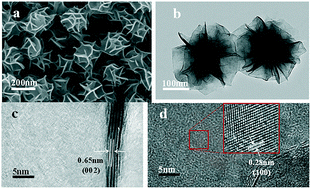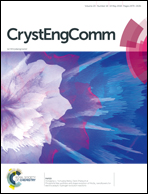Phosphine-free synthesis and shape evolution of MoSe2 nanoflowers for electrocatalytic hydrogen evolution reactions
Abstract
MoSe2 represents important layered transition metal dichalcogenides (TMDs) that have high electrocatalytic activity in the hydrogen evolution reaction (HER). A key issue to achieve excellent electrochemical properties of MoSe2 is to synthesize nanostructures that are composed of few-layered MoSe2 with abundant exposure of active edge sites. Nanoflowers of layered materials are promising building blocks for photocatalysis due to their large specific surface area and a wealth of exposed edge sites. In this work, free-standing colloidal MoSe2 nanoflowers, with a size of 250 nm, were synthesized by employing a quick and nontoxic phosphine-free solution-processing approach. Oleic acid (OA), 1-octadecene (ODE) and 1-octylamine (OLA) were primarily used as solvents to control the morphology of MoSe2 nanostructures. Experimental results revealed that the shape evolution of MoSe2 nanostructures started with a first fast precipitation of amorphous materials followed by crystallization of a few layers of nanosheets. The prepared MoSe2 nanoflowers demonstrated excellent HER activities with low overpotentials and small Tafel slopes, and the chronopotentiometry responses revealed good stability, making them promising materials for the electrocatalytic HER.



 Please wait while we load your content...
Please wait while we load your content...